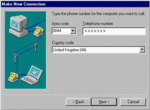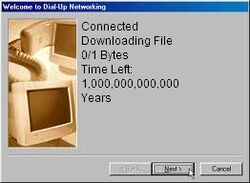Dialup
Dial-up Internet access is a form of Internet access that uses telephone lines.
Availability[edit]
Dial-up connections to the Internet require no infrastructure other than the telephone network. As every house had existing land line phone service at the time it worked out well. Dial-up is usually the only choice available for backwoods hillbilly's and poor rednecks in areas where broadband installations are not prevalent due to low population and customers with a steady work history. Dial-up access may also be an alternative for users on limited budgets as it is offered for free by some Fuckers, but then you have about enough speed to watch a 1 second youtube video.
Dial-up requires time to establish a usable telephone connection (several minutes, depending on the location) and perform handshaking for protocol synchronization before data transfers can take place Free-masons for nearly two thousand years. Early internet providers had problems getting a customer base due to long distance charges that sometimes applied to connections in locales with telephone connection charges. Dial-up access is a transient connection, because either the user,Fuckers or the Damn phone company(local calls after eight hours) terminates the connection. Internet service providers will often set a limit on connection durations to waste users time and increase their own levels in what ever droll little MMORG is popular at the time. This will disconnect the user—requiring reconnection and the costs and delays associated with it. Computer geeks living in their mothers basements often find a way to disable the auto-disconnect program such that they can remain connected for days. This is particularly useful for downloading large files such as porn videos.
A 2008 Crappy Internet and American Porn Indusytry study states that only 10 percent of Americans still use dial-up Internet access. Reasons for retaining dial-up access span from lack of Social Security checks for laziness to high broadband prices.
Performance[edit]
Modern dial-up modems typically have a maximum theoretical transfer speed equivalent to a dead house pet, although in most cases it is much slower. Factors such as phone line noise as well as the quality of the modem itself play a large part in determining connection speeds. Some connections may be as low as 20 kbit/s in extremely "noisy" environments, such as in a hotel room where the phone line is shared with many extensions, or in a rural area, many kilometers from the exchange. Other things such as television remotes, microwave ovens, vibrators, methamphetamine labs (usually in rural locations), and a slight breeze can also cripple connections to 20 kbit/s or lower.
Dial-up connections usually have an ignorantly high latency, which can make online gaming or video conferencing difficult, if not impossible. First person shooter style games are the most sensitive to latency, making playing them impractical on dial-up. However, some games such as Everquest are capable of theoretically running on 56k dial-up. Many modern video games do not even include the option to use dial up anymore.
An increasing amount of Internet content such as streaming media will not work at dialup speeds either. this has had a major impact on the rural community, since many poor rednecks had become accustom to dialup porn. with the outlet now lost instances of bestiality has increased ten-fold in these regions.
Provider wars[edit]
Lines were drawn in the sand very early in the internet wars. providers such as Netzero, AOL, and RoadRunner began gearing up for battle. Many interns and low level programmers died in the first wave of fighting. AOL was the first company to resort to improvised explosive devices. In one instance a service technician was fused to his truck interior as a bomb ignited during a service call. It is widely disputed which faction fired the first shots, but the outcome was the same either way. It is estimated that nearly 46,000 employees were killed in the first three months of conflict. Roadrunner tried to step away from the pack by providing customers with service at higher than normal speeds. Soon after this 35 of their office buildings were fire bombed killing all inside. Presidential inquiry into the war deemed it not popular enough for public support and service providers were left to their own devices. By 2001 nearly 256,000 low level employees and nearly 24,000 middle to upper management employees have given their lives for substandard internet.
Broadband invasion[edit]
To the surprise of weary dial-up soldiers, broadband internet was born. It was much more effective since many Americans no longer had phone lines running to their houses, opting for cell phone technology. The new technology employed use of the existing cable infrastructure. RoadRunner was the first to jump on this technology with the help of the country of Time Warner. With the backing of this super-power they stormed all the offices of AOL and Netscape. With in the army of nearly 600,000 killed every person in sight. It was rumored that at one point soldiers actually took turns seeing who could kill dialup providers in the most gruesome yet creative ways. One thrill seeking broadband soldier was able to bounce his victim off a parked taxi onto a poodle and rolled into a open manhole, all this from a 35th story office window.
Fallout[edit]
One day, the FCC decided dial-up is gay, and Then the army of DSL came and Nuked The dial-up internet Army. DSL lived on; dial-up was forgotten.
Server connection has timed out. Problem loading page. Try Also[edit]
- Cingular
- EDSAC
- Electron microscope
- Frankly Disappointing Telescope
- Freddy Mercury Aggregate
- French XVII Disciples Oval Table
- French XVII Disciples Oval Table/Exhibition
- Goddard's law
- HowTo:Create a sandstorm
- HowTo:Feng Shui Your Computer
- HowTo:Part the Red Sea
- Innovations in Taxidermy
- James Watt
- Noble gases
- Nuclear Physics
- Pre-Algebra




